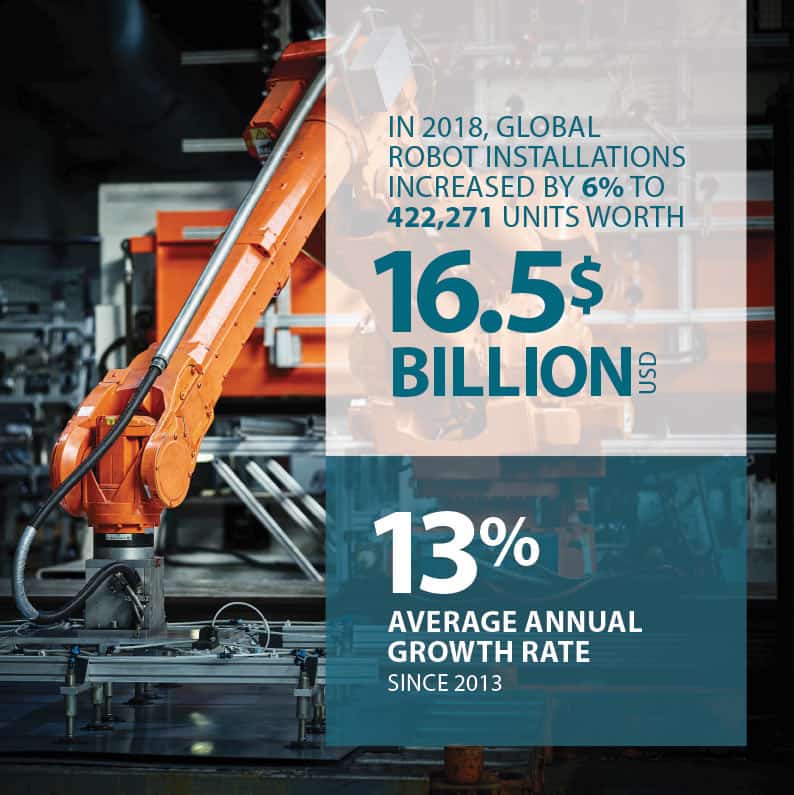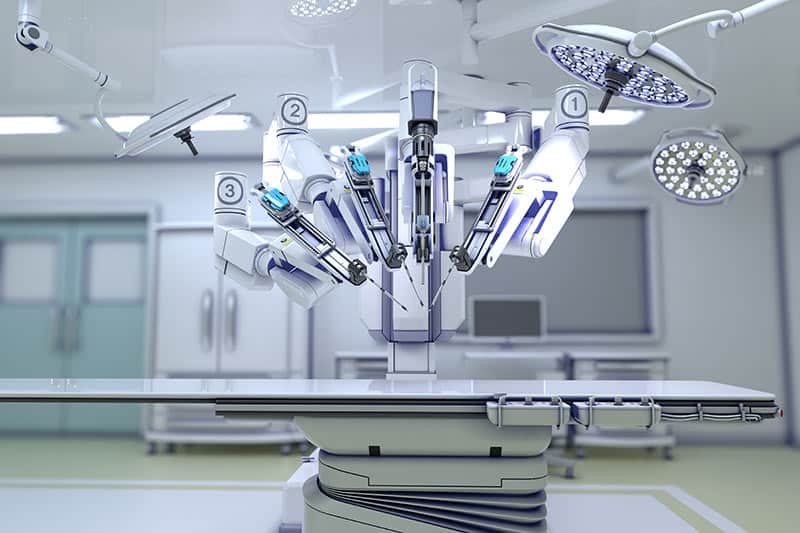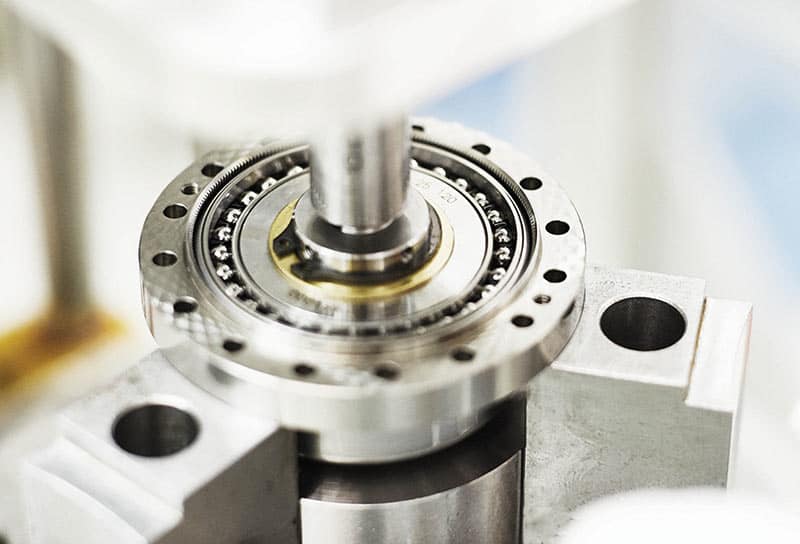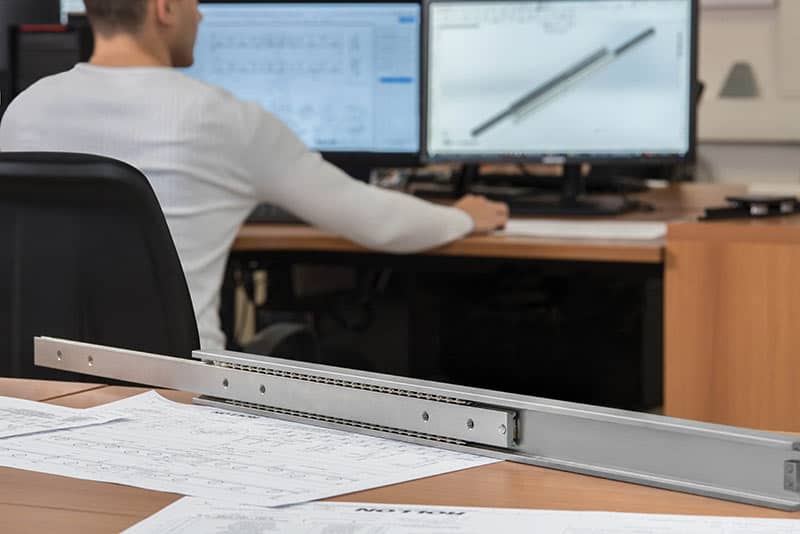Growth
Positioning Timken for Robotic Leadership
The world is entering an increasingly automated industrial age. Industrial robots are eliminating human error and dangerous workplace situations. They’re enabling continued growth in places where the labor force is shrinking. And, they’re helping human workers focus on big-picture solutions rather than on repetitive tasks.
According to the International Federation of Robotics, industrial robot sales doubled globally from 2013 to 2017, and reached a record USD $16.5 billion in sales in 2018. While automotive and electronics manufacturers remain the largest adopters with about 45% of the market between them, the industry is diversifying. Food and beverage has doubled its robot installations since 2013, for example, seeing a 73% increase in the U.S. in 2018.
Timken made significant moves into the robotics market in 2018 when it purchased Cone Drive and The Rollon Group. Both businesses feature notable investments in robotics and are positioned well to serve customers in this market.

Identifying an opening in the market
When Kurt Gamelin, president of Cone Drive, decided to direct more resources into robotics a few years ago, the company had already established leadership in precision motion control. Its Accudrive product line has served the servomotor market—common in automated manufacturing and computer controlled (CNC) machinery as well as robotics—for most of the past decade.
Cone Drive is known for developing technologically complex products with a high barrier to entry. In 2015, the company’s existing product lines were doing well and Gamelin was looking for opportunities to leverage that value proposition.
Robotics and automation fit the bill, and Gamelin’s team saw an opening in harmonic drive systems, a market that is growing by nearly 50% annually, according to the World Robotics Report. “Just about every robot in the world gets at least two,” says Gamelin.
Original equipment manufacturers (OEMs) were on the lookout for capable sources. With no viable acquisition target in the market, the Cone Drive team decided to develop a solution organically.
“Cone Drive excels at product development. We have strong engineers and good processes in place, as well as a state-of-the-art dynamometer testing facility.”
The all-important horizontal axis
Rudi Knevels, president of Rollon, says his company’s investment in robotics and automation was a logical extension of a successful business model. “Rollon started with a market niche in the machinery industry, producing customized linear and telescopic motion solutions,” he says.
In 2006, Knevels was charged with expanding the company’s sales strategy and today, the logistics and railway markets rely on Rollon for linear motion products. It’s also strong in the commercial airline industry, designing motion systems for everything from seat tracking systems to baggage carriers.
“We can customize just about anything for any application,” says Knevels. “We’re constantly searching for growth pockets in industrial sectors where customers are looking for unique solutions rather than commodity products.”
Robotics naturally caught his eye. “It was a driver for us to enlarge our range of actuators and systems,” he says. “Customers in robotics and automation prefer to buy complete systems or actuators designed for specific applications, rather than single components.”
Two acquisitions in 2011 helped transform the company’s linear motion systems offering. Today, Rollon’s linear actuators and systems help factory automation designers, logistics companies and OEMs add a horizontal axis to robots that can already move in every other direction.
“Up to seven percent of all industrial robots installed around the world are equipped with a seventh axis,” says Knevels. “The estimated market size is USD $360 million, and it’s growing fast.”
Customized harmonic solutions. Fast.
While both Rollon and Cone Drive are at the beginning stages of their investments in robotics, both are already generating revenue as a result.
Cone Drive is in various stages of development with several top-level robotics OEMs for harmonic solutions, which are common in the industrial robots that automotive manufacturers use for painting, welding, and assembly. They also play a central role in the new collaborative robots (cobots) that work side by side with humans.
Medical equipment manufacturers use harmonic solutions in imaging machines and surgical tables, says Gamelin. “We also see them in satellite positioning systems, indexing mechanisms, and automated vehicles that the military uses for detecting explosives.”

Product tests show that Cone Drive engineers are breaking through the high barrier to entry for harmonic drive systems. “Our testing facility is a differentiator for customers,” he says.

The company’s lead times also make it stand out. Because each industry and each robot come with unique motion specifications, nearly every harmonic system that Cone Drive builds is customized. “We can engineer special orders quickly,” says Gamelin, which makes a difference in today’s dynamic markets.
Streamlining the seventh axis
Rollon also stands on its customization strengths and short delivery times to gain market share in robotics and factory automation. The company’s flagship product for robotics—its Seventh Axis shuttle system—moves heavy robots on a horizontal axis. Each system is built on a modular platform, which helps the company reduce costs and keep delivery times short, while building to custom specifications.
Because Rollon focuses more than 80% of its business on customized solutions, it has a high degree of recurring business. The company focuses heavily on partnering with OEMs, but also works directly with industry sectors. Automotive manufacturers, for example, use Seventh Axis systems to move hot metal sheets from oven to metal press, taking humans out of dangerous situations.
Customers also reduce capital costs and increase efficiency when they replace multiple static robots with one robot that moves horizontally. Large online retailers increasingly use warehouse robots to move products from shelves to shipping containers.

The machine tool industry is another growing market. Today, robots often drive tool-changing activities or working piece changes, and those robots move on linear actuators.
The seventh axis represents a market ripe for innovation and streamlined solutions. “Today, many robot users buy components from different suppliers and build their own linear systems,” says Knevels. Seventh Axis systems replace those homemade solutions, easily integrating with any type of robot and capable of being mounted on floor, ceiling or wall.
The benefits of integration
Both Rollon and Cone Drive customers benefit from the business’ integration with Timken, in terms of innovation and product development. “Timken has an extensive metallurgy knowledge base, and we collaborate with them on solving various technical challenges including material, heat treating and surface hardening analysis,” says Gamelin.
On the sales side, he says, “Timken’s global presence gives us more breadth and reach.” South Korea presents an important market as the country with the highest robot density in the world, but neither Rollon nor Cone Drive had a presence there before they became part of Timken. The South Korea team is off and running with Cone Drive’s harmonic line.
Knevels’ team is training new sales engineers in Spain, Canada and Sweden, in addition to South Korea, and he’s excited to connect with more automotive customers, many of whom are pioneers in factory automation.

The benefits go both ways, he says. Rollon customers in the railway and commercial airline spaces also benefit from better access to Timken product lines.
Rollon products present their own synergies, as systems of valves, gear boxes and lubrication systems. “As our volumes grow, we are incorporating more and more highly-engineered Timken products into our actuators and systems,” says Knevels.
Investing in the future
While the collaborative robot market is still small, both Knevels and Gamelin expect humans to welcome more cobots into the work environment over the next few years. Cone Drive’s investment in harmonic solutions positions the company well, says Gamelin. Cobots often use six to eight harmonic systems.
You might think of collaborative robots like collaborative people—walking around on two legs—but Knevels says that’s not necessarily the case. “Many collaborative robots also require a collaborative seventh axis,” he says. Today, the Rollon development team is hard at work solving for those applications.
Rollon is also investing in Industry 4.0 technologies, partnering with software companies and electronics manufacturers to digitize and automate Seventh Axis systems. “At a certain point, that will be the strongest request from our customers,” says Knevels.
The vision: #1 in robotic drive systems
Rollon and Cone Drive became Timken companies as a result of their industry leadership, innovative partnerships, top-notch development processes and strong engineering know-how. Knevels and Gamelin expect those characteristics to help them achieve leadership positions in robotics as well.
To achieve that goal, both leaders are working from a similar playbook: Put customer requirements front and center. Deliver premium products, built to customized specifications, and keep lead times short so that customers can move quickly in the most dynamic markets.
Last Updated: 2024/03/25
Published: 2020/02/6
